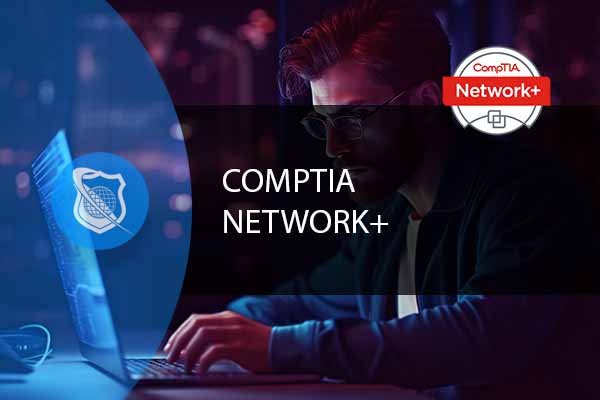
CompTIA Network+ is a certification that validates the essential knowledge and skills needed to confidently design, configure, manage, and troubleshoot any wired and wireless devices. This certification is designed for IT professionals looking to enhance their networking skills and is often seen as a stepping stone for more advanced certifications or career paths in IT infrastructure. Covering a broad range of networking concepts, the Network+ certification ensures that holders understand how networks work, how to maintain them, and how to implement security standards and protocols.

Learn concrete vendor neutral Network fundamentals in our comprehensive CompTIA Network+ traning course.
IT professionals looking to build a foundational understanding of networking concepts, practices, and technologies, including network administrators, system administrators, and IT consultants.
The certification is valid for three years from the date of passing the exam.
Yes, CompTIA provides the option to take the exam online or in-person at a testing center.
There are no formal prerequisites, but it is recommended that candidates have CompTIA A+ certification and at least 9-12 months of networking experience.
CompTIA Network+ focuses on networking concepts and infrastructure, preparing IT professionals to manage and troubleshoot networks. CompTIA Security+, on the other hand, is focused on security concepts and practices, aimed at professionals looking to specialize in IT security.
The CompTIA Network+ certification is an essential credential for professionals in the field of IT networking, signifying a foundational understanding of networking concepts, infrastructure, operations, security, and troubleshooting. Knowing the key terms associated with CompTIA Network+ is vital for individuals pursuing a career in networking, as it ensures they have the necessary vocabulary to understand study materials, pass the certification exam, and communicate effectively in the workplace. Below is a list of key terms and definitions that are fundamental to the CompTIA Network+ certification.
| Term | Definition |
|---|---|
| Networking | The practice of connecting computers and other devices together to share resources such as files, printers, and Internet access. |
| OSI Model | A conceptual framework used to understand network interactions in seven layers: Physical, Data Link, Network, Transport, Session, Presentation, and Application. |
| TCP/IP | A set of protocols governing the Internet, including TCP (Transmission Control Protocol) and IP (Internet Protocol), which dictate how data is transmitted across networks. |
| Subnetting | The process of dividing a network into smaller, manageable parts called subnets to improve performance and security. |
| VLAN (Virtual LAN) | A method to create distinct broadcast domains in a LAN by segmenting a network into smaller networks, improving management and security. |
| Firewall | A security device or software used to control the flow of network traffic between networks or devices, offering protection by blocking unauthorized access while permitting authorized communications. |
| VPN (Virtual Private Network) | A technology that creates a safe and encrypted connection over a less secure network, such as the internet, allowing secure communication between networks or users in different locations. |
| DHCP (Dynamic Host Configuration Protocol) | A network management protocol used to automate the process of configuring devices on IP networks, allowing them to use network services such as DNS, NTP, and any communication protocol based on UDP or TCP. |
| NAT (Network Address Translation) | A method of remapping one IP address space into another by modifying network address information in the IP header of packets while they are in transit across a traffic routing device. |
| WLAN (Wireless LAN) | A local area network that uses radio waves to connect devices such as computers and mobile devices to the Internet and to each other without the use of wires. |
| QoS (Quality of Service) | The description or measurement of the overall performance of a service, such as a telephony or computer network or a cloud computing service, particularly the performance seen by the users of the network. |
| IPv4 | The fourth version of the Internet Protocol, which uses a 32-bit address scheme allowing for a total of approximately 4.3 billion addresses. |
| IPv6 | The most recent version of the Internet Protocol, designed to replace IPv4, using a 128-bit address space to support a virtually unlimited number of unique IP addresses. |
| DNS (Domain Name System) | The hierarchical and decentralized naming system used to identify computers, services, and other resources reachable through the Internet or other IP networks by translating human-readable names to IP addresses. |
| Switch | A networking device that connects devices together on a computer network, using packet switching to receive, process, and forward data to the destination device. |
| Router | A networking device that forwards data packets between computer networks, performing traffic directing functions on the Internet. |
| WAN (Wide Area Network) | A telecommunications network that extends over a large geographic area for the primary purpose of computer networking. Wide area networks are often established with leased telecommunication circuits. |
| LAN (Local Area Network) | A network that connects computers and devices in a limited geographical area such as a home, school, computer laboratory, or office building. |
| Protocol | A set of rules or procedures for transmitting data between electronic devices, such as computers. In networking, protocols include TCP/IP, HTTP, SMTP, and FTP. |
| Bandwidth | The maximum rate of data transfer across a given path or connection in a network, usually measured in bits per second (bps). |
This list represents the foundational knowledge required to understand and work within the domain of networking, particularly for those aiming to achieve the CompTIA Network+ certification.
Lorem ipsum dolor sit amet, consectetur adipiscing elit. Ut elit tellus, luctus nec ullamcorper mattis, pulvinar dapibus leo.
$49.99 Original price was: $49.99.$16.99Current price is: $16.99. / month with a 10-day free trial
ENDING THIS WEEKEND: Train for LIFE at our lowest price. Buy once and never have to pay for IT Training Again.